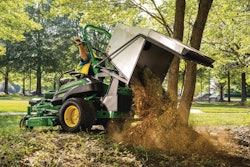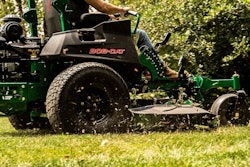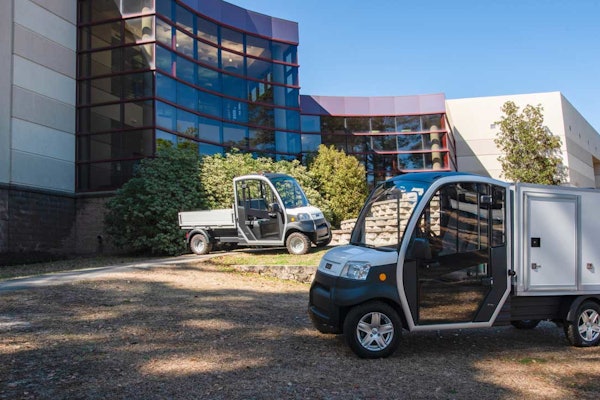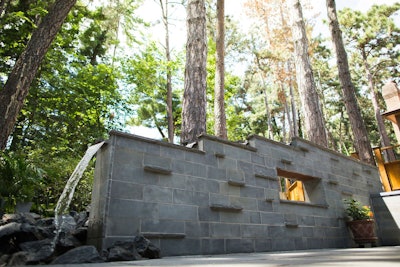 Photo: Colin Conces
Photo: Colin ConcesWith the warmer months in full swing, your clients are surely flocking to the outdoors, which means it could be a good time to make a few additions to their space.
One unique water feature your customers might be interested in this season is a pondless waterfall. Total Landscape Care talked with Hugh Morton, co-owner of Sun Valley Landscaping in Omaha, Nebraska, to get the scoop on these popular water features.
Going pondless
Morton says when they first began installing pondless waterfalls, they utilized the Aquascapes prefab units to get rid of the lower body of water while still having the capacity to hold the amount of water needed to circulate within a larger system.
“You’re losing water at the bottom base, so we came up with these systems to hold all that water in place and still access the pump and the maintenance on that end,” says Morton. “But we wanted to eliminate exposed water or at least the body of water that would attract mosquitoes and algae and lower the headache for our clients to let them enjoy it more.”
Morton says that with traditional backyard waterfalls, there is always maintenance that accompanies it, whether it’s caring for fish, dealing with the surrounding plants or unpleasant odors. This, he says, is why pondless waterfalls carry so much appeal.
Unlike traditional backyard waterfalls, a pondless waterfall won’t have an area of exposed water at the bottom. The water will, instead, flow into a gravel or rock-covered catch space at the bottom of the feature and continue to circulate via a hidden pump and tube system.
 Photo: Aquascapes
Photo: Aquascapes“You cover up the tube so it’s safe and nobody can get in there, and the pump sits at the bottom of the tube,” says Morton. “So, as you have water displacement, evaporation or water loss, the water drops all the way to the bottom of this basin and the pump can still pull from that water source without the client having to fill it.”
Depending on the system, Morton says customers might have to refill it once every three weeks or once a month. He adds that an auto system can also be used to reduce maintenance even more.
Rise in popularity
Morton says about 90-95 percent of the water feature projects they do are some form of pondless install, and this, he thinks, is due in part to their low maintenance.
“It’s trending really hard and it’s reflecting in the number of companies that are offering these products,” says Morton.
While Morton says full backyard waterfall designs do still have their attractions, such as live fish, water sounds, more plant life and added aesthetics, they can sometimes be a little more than customers are wanting to deal with on a daily basis. This, he says, is where the pondless water features can shine, as they still offer many of these same attributes but with almost no maintenance required.
“Basically, you’re getting all of the aspects that you’re getting in a regular water feature design without having to see a dirty, smelly, maybe mosquito-infested lower basin,” says Morton. “I’m sure the sustainability aspect is a big draw, too, since it’s just recirculating that water. And there are certain systems we can use that let us use downspout or reclaimed water.”
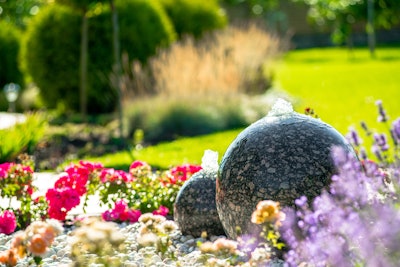 Photo: Shutterstock
Photo: ShutterstockMorton says another popular option is a pondless fountain, which can manifest as bubbling boulders or vases with water gurgling up and cascading down the side.
Overall, Morton says the main complaint he’s received from clients regarding their pondless water feature is the occasional buildup of calcium and algae on the catch basin rocks, but Morton says this can easily be cleaned off in no time.
He does add that they can attract wildlife, but that’s not always considered a downside for their customers. Very rarely, he says a client will complain about the water’s smell, but if this happens, there is a small amount of a cleaning chemical that can be added to the feature to help keep the water flowing and cut down on stagnation.
Installation
Morton says there is such a huge industry for creating pondless water features that customers can virtually get any size they desire.
When installing a pondless water feature, Morton says the most important part of the design is making sure that you’re sizing the bottom basin appropriately.
“You size it, and it displaces a certain percentage of water up into the top in the stream,” he says. “And when the client turns that off for maintenance or is going on vacation, then you want to make sure that the lower basin can hold all that water that’s currently in the stream as well.”
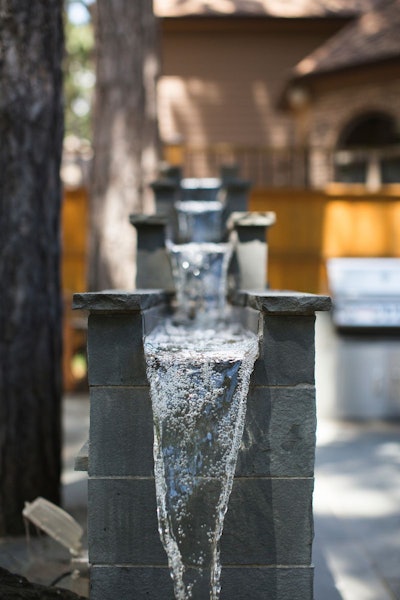 Photo: Colin Conces
Photo: Colin ConcesOnce the feature is installed, Morton says it just comes down to waiting for the surrounding plant material to grow in and really fill in the space. After the plants have had a chance to grow and fill out, Morton says there’s more of a mysterious element to the feature, as the water sometimes looks like it’s flowing out of the bushes or acts as a hiding element for the tubing.
For simple, smaller, bubbling features that are self-contained, measure about 8 feet in diameter and don’t feature any hills, Morton says the price could range from $2,400 to $3,000. This price, he says, can also vary based on what elements the customer wants in the feature, such as a custom made piece or a drilled out boulder.
When looking into adding waterfalls, Morton says there are really no limits, but he does divide them into three categories. Starter systems that are about 10 to 15-foot-long, have a couple of waterfall drops and a nice meandering stream can run between $4,000-$7,000.
In the $6,000-$10,000 range, Morton says customers could go for a 15 to 20-foot-long feature with waterfall drops, a pooling area that pulls water out and allows it to sit awhile, a possible area where customers can walk across the pooled section and the possible addition of boulders.
The final category falls in the $12,000-$16,000 range and consists of long, elaborate waterfalls, ponds, different rock elements and much more.
Mistakes to avoid
Morton reiterates that one of the biggest mistakes that can happen when installing a pondless water feature is not appropriately sizing the basin, as you can’t fix something later in the process that wasn’t sized properly in the beginning.
“If you don’t educate the client enough on what you’re putting in and they want more and the splash gets outside of the system, you could literally lose 100 to 200 gallons of water in half a night,” says Morton.
Another thing to watch out for is access to the pump. Morton says it’s always important to have easy access to the pump in case something goes wrong or if it’s time to shut the system down for the winter.
A third mistake he’s seen time and time again is shorting your materials. Morton says you can’t feel pressured to fit something into a budget if it’s going to take twice as much material to make the project look good. Morton adds that without the proper amount of material, your designers also won’t be able to accurately and artistically do their job.
“There are other ways to hit budgets than trying to reduce your price to the point where you don’t have enough to create look that you want,” says Morton.
For customers wanting to increase the curb appeal of their home, Morton says adding in water features can also be a lower-cost way to increase resale value.

